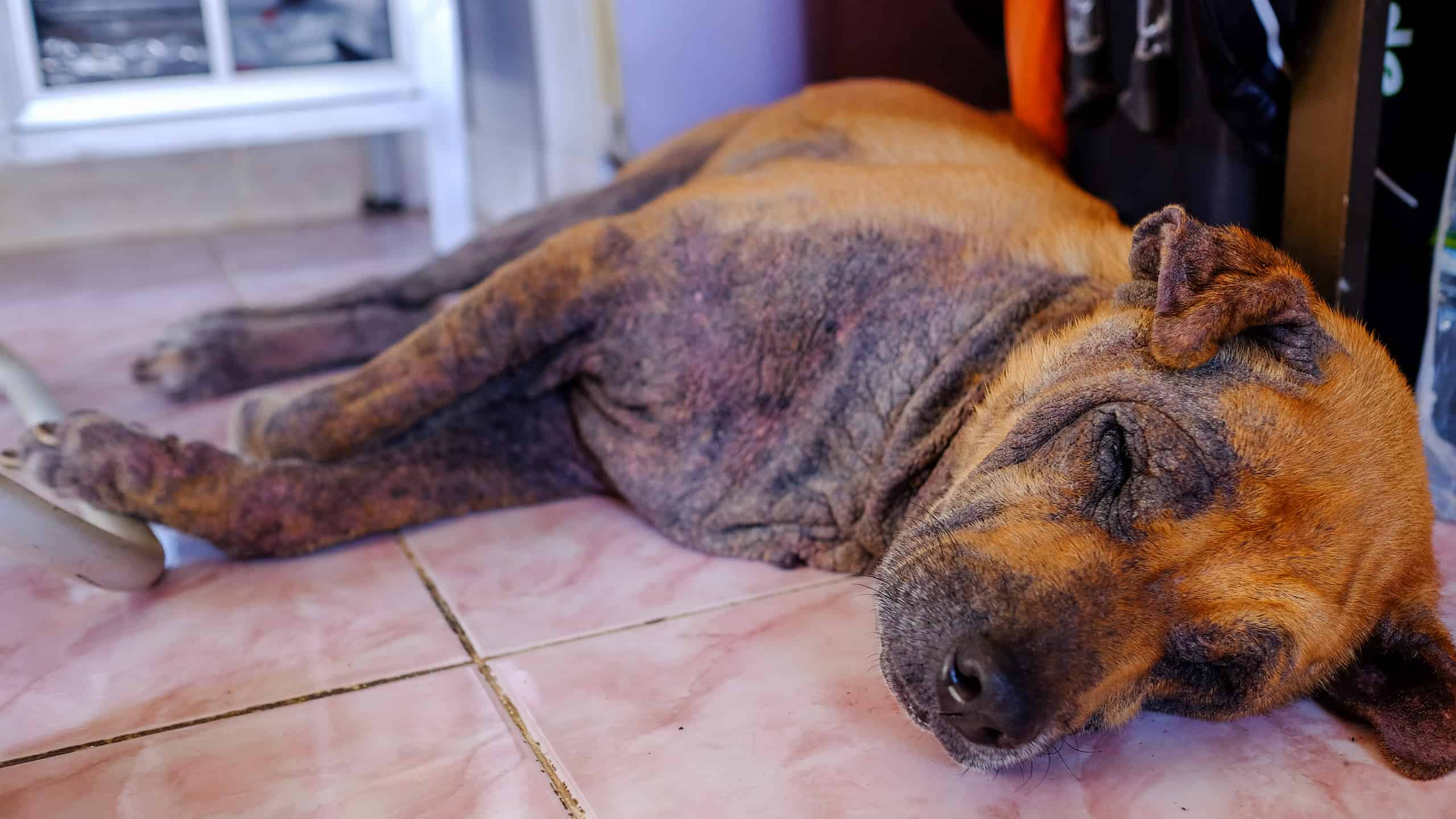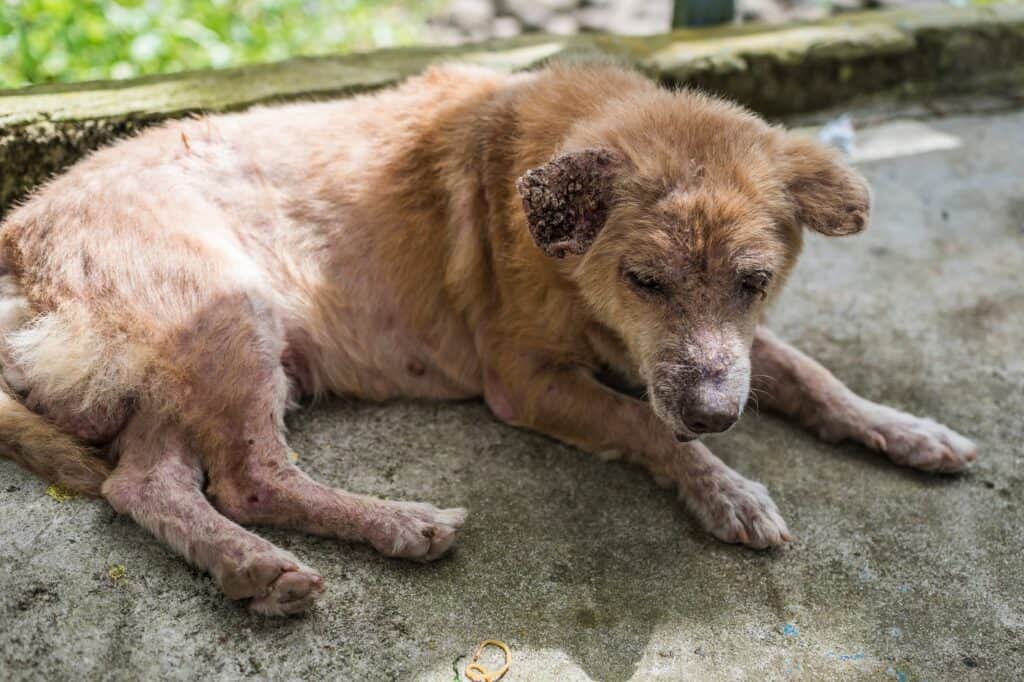
©MDV Edwards/Shutterstock.com
The decision to have a dog is a big choice then there’s caring for the dog. One of the most important parts of dog ownership is keeping your buddy healthy and happy. Certain breeds require specific types of nutrition, and staying on top of that throughout their lives is essential. Without proper nutrition, your dog can become deficient in vitamins that might cause further problems down the road. One of those problems could be mange.
What is Mange?

Demodex Mites only live for around two weeks, so they store waste without releasing it.
©Kalcutta/Shutterstock.com
Mange is a skin disease of mammals caused by parasitic sarcoptic or demodectic mites feasting on the skin. Sarcoptic mites live under the skin’s surface, whereas demodectic mites live on the hair follicle above the skin. Mites belong to the arachnid subclass Acari; another name for mange is acariasis.
Sarcoptic Mange
Sarcoptic mites are also called canine scabies. It is zoonotic, meaning it can be shared from animal to human. It is highly contagious through skin contact with an affected animal. Most furred mammals can catch this type of mange. When the microscopic mite burrows into the skin and defecates, the host undergoes an allergic reaction to the mite’s feces.
Mites can infest the host quickly, causing intense itching that leads to hair loss and scabs. With so much itching, infection can easily set in, and that is when you will begin to experience a whole new set of issues. In wildlife, mange can mean life or death. A fox infected with mange can develop severe scabs and crusting of mites on the skin’s surface. It can crust over the eyes and cause blindness if left untreated.
Sarcoptic mange tends to attack mammals with weakened immune responses and vitamin deficiencies. Young, starving, or sick animals are much more susceptible to catching mange than healthy animals.
Demodectic Mange
Demodectic mange or red mange is a sensitivity to Demodex. The Demodex canis mite causes it. These mites are part of the flora makeup of your dog’s skin but can become out of control on a puppy or dog with a weakened immune system.
When humans contract demodectic mites, it is called demodicosis. It is not zoonotic, so your dog cannot catch it. It is relatively rare in humans, and the symptoms are generally mild. If your dog has it, you will not be able to catch it because demodectic mange is species-specific and not transferable from species to species.
When a dog has demodectic mange, chances are it can recover independently with proper nutrition and care. If the mother dog passed this on to her puppies, it should resolve as their immune systems strengthen. In the case of older dogs with immune conditions like diabetes or cancer, it will be harder to keep under control. Boosting nutrition and skin care should be sought.
How is Mange Contracted?

©iStock.com/Cristian Martin
Demodectic Mange
Your canine pal wants to live their best life with you, which means not itching like crazy. Demodectic mange is not contracted because these mites always live on the skin. They feast on dead skin and lay eggs just underneath it so their offspring will have vital food upon hatching.
The best way to keep demodectic mites in check is to feed your canine friend healthy, well-balanced meals. A trip to the vet to rule out conditions affecting the immune system is also a great idea. Some puppies may have this type of mange shortly after birth, and it can be that they’ve inherited immuno issues that could require extra care to manage. Speak with your vet if you have any concerns or questions.
Sarcoptic Mange
With sarcoptic mange, the story is a bit different. Sarcoptic mange is exceptionally contagious between mammals and can also infect you. Typically, the symptoms will appear ten days to eight weeks after contact with an infected dog.
It is imperative to thoroughly wash all bedding and items the dog has come into contact with in hot water to kill the mites and prevent spreading. If your dog has mites, frequent washing with vet-approved formulas will help with the itching.
Early Stage Mange
No matter what type of mange your canine friend is dealing with, the symptoms will be similar. In the beginning, you will notice your pet scratching a lot more than usual, but without treatment, this will progress into a body covered in scabs, crusts from the mites, and infection. Without proper care, your dog could go blind or cause a severe infection by knawing on their feet or other body parts.
When you notice itching, hot spots, or anything unusual, take your dog to the vet and have it checked out. Without treatment, your canine friend will suffer, but it will also create a negative trickle-down effect for animals who come into contact with your dog or yard. The longer mange persists, the more cleaning you will need to do to your home and yard.
Sarcoptic mange is challenging to eliminate in the environment, but it’s doable. Dusting your yard with food-grade Diatomaceous Earth is a safe and easy way to kill the mites in your dog’s yard. You can also thoroughly dust your dog’s body and hair with it, but be careful; many people are sensitive to fine dust. DE is baby powder fine and can be detrimental to those who suffer from asthma. It can also cause lung issues, sneezing, and watery eyes.
Itching

One of the early indications of mange is the almost constant itching it causes.
©Photo-Vista.de/Shutterstock.com
At the beginning of the infestation, your dog will begin itching. They will gnaw at their paws and itch their ears a lot, sometimes whimpering. This endless itching will be at the top of your dog’s list of priorities, and they will itch and lick so much that you will notice hair loss. It’s safe to assume this itching is incredibly miserable, and you should seek treatment for your dog at the vet ASAP.
Hot Spots
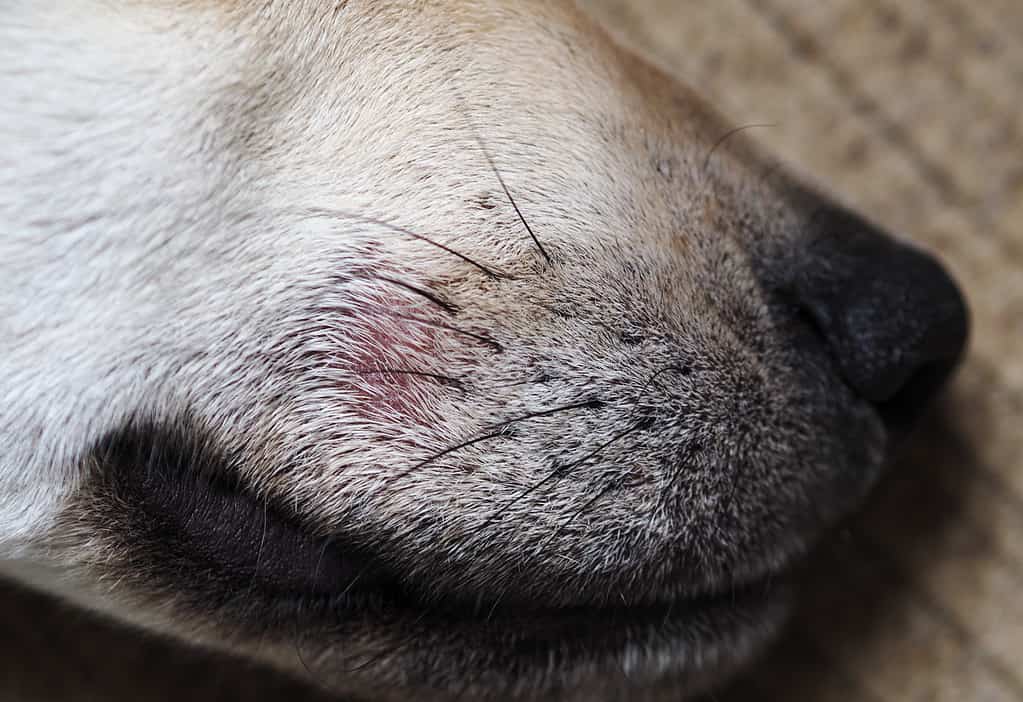
Canine demodex mange causes hot spots and itching that can start on the muzzle or feet.
Once your pup has been itching for a short time, you will notice obvious evidence of the mites. Your dog will develop hot spots where the skin that has been itched will swell and appear red. The location will be warm to the touch from all the itching and irritation. These spots often first appear on the muzzle and feet but can appear first in any area of your dog’s body with creases or folds.
Hair Loss
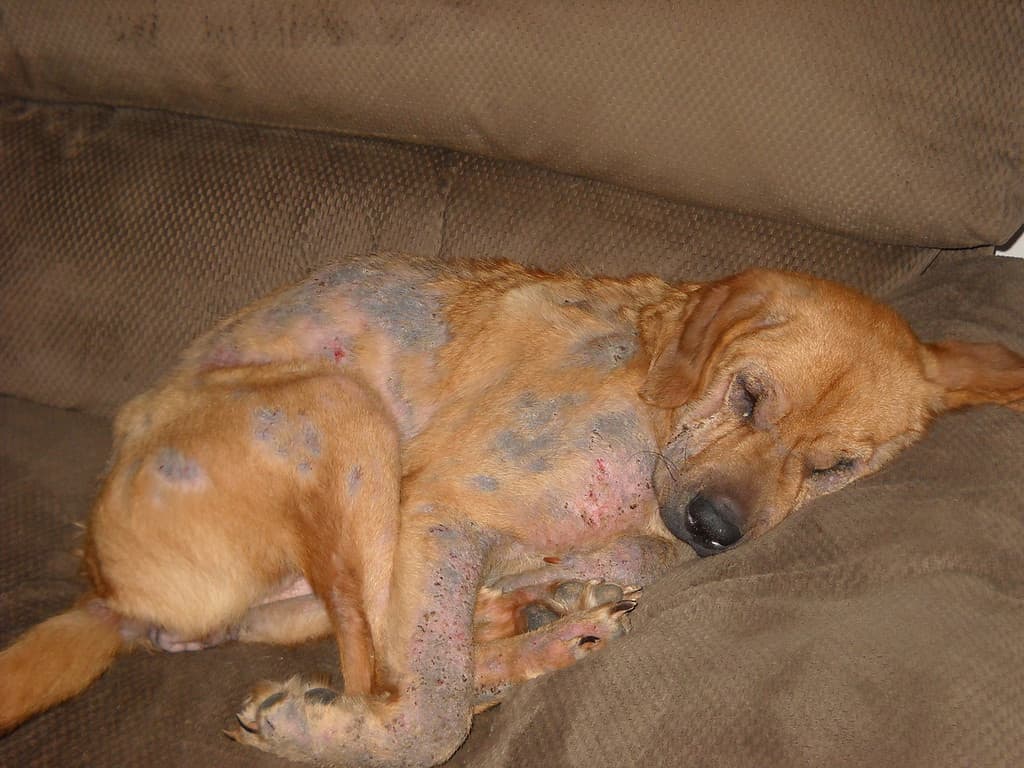
Demodectic mange causes hair loss, itching, and crusting of the dog’s skin.
As the mange infection progresses, you will notice your dog losing hair around the itchiest spots. After a while, your pup will not simply have a few bald spots but become unrecognizable with hair loss. Without the protective barrier of hair between your dog’s skin and its teeth, the itching can take an ugly turn. With the constant knawing and licking of its skin, your dog is now susceptible to open wounds and infection. Since the immune system is already weakened, you do not want your dog to create open wounds or become infected. This can become very serious.
Crust, Pus, Scabs, and Discharge
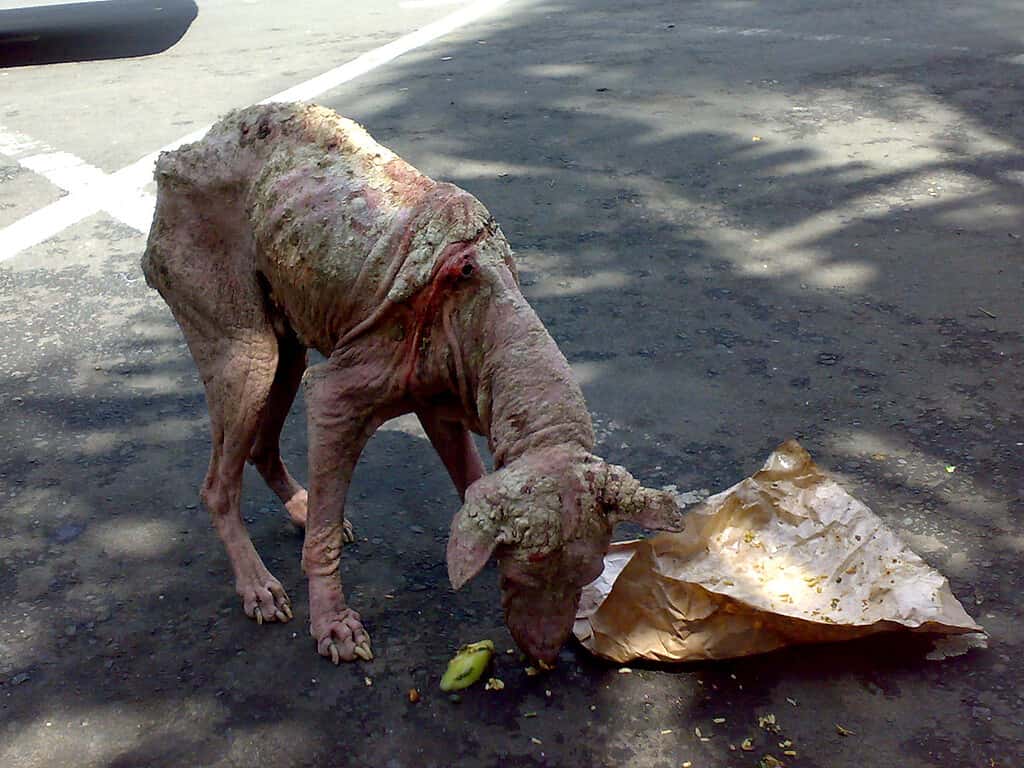
A dog with severe mange.
©Jack Merridew / Public domain, via Wikimedia Commons – Original / License
The final stage of mange is unsightly. Your dog will have lost all of its hair and be covered in a thick crust from the mites and scabs. The infection will have set in, and serious medical help will be needed. If your dog gets to this stage while in mange treatment, consult with your vet on the next treatment strategy. Wild animals that reach this point almost always succumb to their wounds. Constant itching, blindness from mite crust covering their eyelids, and creating terrible conjunctivitis makes hunting almost impossible. Luckily, with the appropriate vet care, your pup will never get as bad as some wildlife and stray dogs and will be fine after treatment.
Conclusion
With the correct vet care and plan to keep your dog safe from mange, you and your pup will return to the dog park in no time. Ensure you get the okay from your vet before putting your dog around other animals. You don’t want a situation where you finish caring for one mange-infested dog only to realize your other dog or cat has now developed mange. Mange in cats generally starts with a very itchy head; take the proper precautions so other creatures do not catch your dog’s mange.
Once your vet ends treatment for your itchy dog, it will take a bit of time for your dog’s skin to recover fully and for hair to grow back. Providing skin-healing, anti-itch baths during this time is essential. Many over-the-counter anti-itch dog shampoos contain ingredients that can exasperate itchiness. Check with your vet on what they recommend using to avoid further issues.
As a follow-up to any type of mange, make sure to feed your dog a balanced and healthy diet. Lower-quality dog foods cost less for a reason, and in the end, you will make up more than that cost in vet trips for a malnourished or unwell dog. Lots of dog foods have fillers that equate to corn, soy, and wheat, which are all things that shouldn’t be significant parts of a canine’s diet. Itching can also happen due to food allergies, and the biggest culprit of food allergies with dogs is the fillers.
Grain-free dog food is only for special cases. Dogs require grains to keep their stomach’s happy and healthy. Choosing the appropriate and most nutritious grains is a must since there is a lot of misinformation out there. Once again (broken record here), check with your vet. They are a wealth of knowledge and can steer you toward food that will be the most beneficial, safest, and healthiest for your canine pal.
FAQ
Q: What is mistaken for mange in dogs?
A: Mange can be mistaken for season allergies and vice versa. Allergies can cause scratching, chewing, hot spots, and fur loss. Be sure to check with your vet to receive a proper diagnosis.
Q: Can you touch a dog with mange?
A: If you need to touch a dog with mange, wear protective clothing and gloves to lessen the risk of transmitting mange to other animals or humans. Until you know the type of mange, do not allow your dog around other animals. Sarcoptic mange is highly contagious and can be life-threatening to sick, elderly, young, or immune-compromised animals
Q: Can mange live on dog beds?
A: Unfortunately, with sarcoptic mange being so contagious, it is probably safer to throw away a dog bed once the dog is free from mange than to attempt to clean it. You don’t want a re-infestation! If your dog has demodex mange, you should be able to wash the bed in the washing machine with hot water to rid it of leftover mites. Remember, Demodex mites naturally live on the skin anyway. It is only when an immune system is compromised that the mites have a chance to become a problem.
Ready to discover the top 10 cutest dog breeds in the entire world?
How about the fastest dogs, the largest dogs and those that are -- quite frankly -- just the kindest dogs on the planet? Each day, AZ Animals sends out lists just like this to our thousands of email subscribers. And the best part? It's FREE. Join today by entering your email below.
Thank you for reading! Have some feedback for us? Contact the AZ Animals editorial team.

